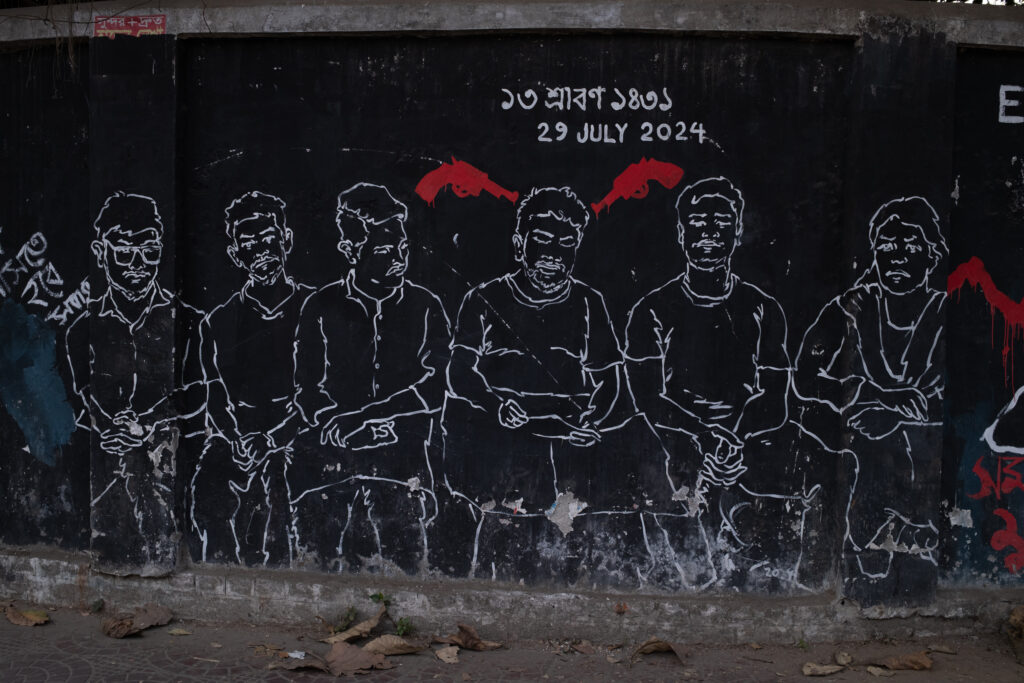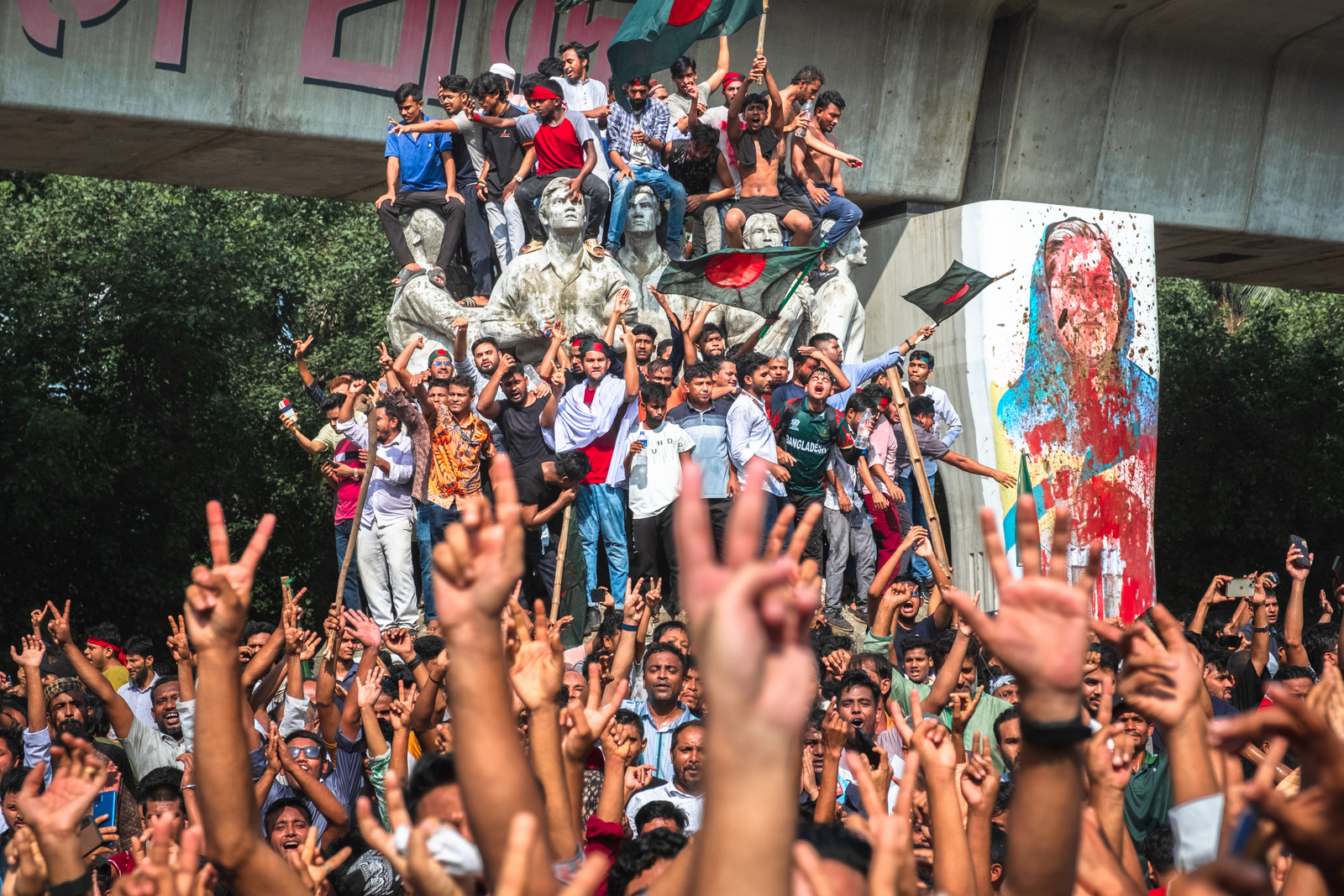This post is Part Two of “The Bangladesh Chapter” of the b2o review’s “The University in Turmoil: Global Perspectives” dossier.
Shomonnoyok or Who Wants to Be a Student Leader?
Naveeda Khan, Bareesh Hasan Chowdhury, and Shrobona Shafique Dipti
On July 26, 2024, the police in Dhaka city picked up three students by the names of Nahid Islam, Abu Baker Majumdar and Asif Mahmud. Over the next two day, three more students were taken into custody: Sarjis Alam, Hasnat Abdullah, and–the only woman in the initial group–Nusrat Tabassum. The 2024 Quota Reform Movement had already turned violent by this time: the Awami League’s student organization had begun beating the protestors; the police had fired on unarmed crowds; and some in the public had retaliated by burning government buildings and infrastructure.
This instance of the police detaining students had broader consequences. It had broader consequences because by taking in specific students the Sheikh Hasina government was for the first time acknowledging that the movement was not just composed of innocent (read “ignorant”) students being manipulated by anti-state agitators; it was after all an organized effort led by the students themselves. The government could not help but identify several students as leaders of the movement simply by picking them up, supposedly for their own protection. Among these student leaders, Nahid Islam had already been picked up earlier and beaten, no doubt because he was most visible in the media. But this group sweep suggested that the Awami League government felt they had identified and seized the most influential of the student leaders, without whom the protests would surely come to a halt. This action repeated the strategy of the government during the 2018 Quota Movement when several key leaders were taken into custody by the detective branch of the police to break the movement.
This performance of concern for the student leaders—they weren’t being arrested; they were being taken into protective custody—was also violent in a psychological sense as it forced the six students to partake in televised displays of their cordial relations with the police. They were filmed sharing a meal with their captors. For many, the scene of the students gathered in the main detective branch of the Dhaka Metropolitan Police to take a meal with the notorious chief of the branch, Harun-ur Rashid (also referred to as DB Harun), evoked many earlier scenes. In them DB Harun was shown on television to be breaking bread with those he had picked up without warrant and, one heard, was mistreating, if not torturing, sometimes before these tablemates were permanently “disappeared.” There was a macabre humor to the students being feted in what had come to be referred to as “Harun’s Rice Hotel” (“Haruner Bhater Hotel”).

©Shrobona Shafique Dipti, graffiti at Dhaka University of the six students in custody.
Under ordinary circumstances, the leaders appearing on television, being made to read out a statement calling off the movement, would have marked the end of the student action, cut off at the head, with viewers savoring the forced jollity of condemned prisoners partaking of a last meal. But not this time. Not only did viewers balk at this effort to quell a movement by excising the efforts of the young, but the other students also watching the television performance rejected the statement to call off the movement and openly repudiated the leadership of the six.
The act of seeking out and gathering student coordinators in the police station marked a moment of failed recognition by the government. It failed to recognize that the category of the student coordinator, the self-named shomonnoyok, well exceeded the six who had been picked up, having evolved into a generic category to include anyone willing to take up the reins of organization as befitting the decentralized nature of the movement. True to form, the extorted call to end the protests was answered by other self-proclaimed shomonnoyoks vowing to continue the protests regardless. Many shomonnoyoks in cities such as Chittagong and Rangpur, previously unknown to the public, came to dominate the TV screens and front pages of the newspapers, marking the proliferating lines of the movement in towns and cities outside of the capital.
A precursor to such organizing was the 2018 Road Safety Movement, which had followed the first Quota Movement of 2018. This had been initiated by schoolchildren, who had concluded that their erstwhile pleadings with the government to make roads safe for the young would go unheard. The young protestors had unintentionally adopted a decentralized mode of gathering, shouting slogans such as “neta hotey ashi nain” (“We have not come to be leaders”), only to be met with violence. Perhaps, the decentralized nature of organizing by the current shomonnoyoks was informed by that earlier movement. Undoubtedly many of the school children involved in it were now of age to participate in the 2024 Quota Movement. They likely drew upon their past practices and encounters with the state and violent memories of that past to fuel their mobilization in the present. Or perhaps it was just the call of the hour; the 2024 movement had come too far and reached too deeply into the conscience of Bangladeshi society for it to falter on a statement made clearly under duress by the six shomonnoyoks in the police station. “Bhoi kete giyeche,” “Fear has gone.” The fear that had once tempered protests and empowered the regime had given way.
While a message was shared widely across social media clarifying that students were to offer themselves as mere coordinators and not take on the mantle of leaders, it is not clear by what modality any decision on this question was taken, agreed upon, faithfully transmitted and taken up. The mimetic doubling, redoubling, multiplying of the figure of the shomonnoyoks was so forceful within the movement that the term, previously in general use in Bangladesh to refer to the coordinator of any movement, be it garment factory workers protesting better work conditions and wages or environmentalists protesting pollution, seems likely henceforth to refer only to the countless, effectively nameless leaders of the Quota Reform Movement, a number of whom gave their lives to bring down Hasina.
The importance of the category of the shomonnoyok is manifest even after the fall of the Hasina government and the winding down of street protests. However, it has now gone from being a labile, even generic category donned by anybody to being a marker of some distinction, of a person backed by a successful uprising. Some, such as Abu Sayeed, deemed the first student to be killed in the movement, have been memorialized as martyred shomonnoyoks. Others, such as Nahid Islam and Asif Mahmud of the original six who were imprisoned, have taken up seats in government and acquired distinction that way. Others, such as Umama Fatema, have gained publicity by complaining of women students being left out of government despite being in the maelstrom from the start. But what is interesting is how the very act of claiming the title of shomonnoyok or being deputed by a shomonnoyok has come to indicate that one is authorized. Since the fall of Hasina, there have been notable incidents of those claiming to be shomonnoyoks or authorized by shomonnoyoks to carry out a range of activities, from enforcing change within institutions to rid them of Awami League loyalists to carrying out extortion rackets.
As if to remind us that the title of the shomonnoyok carries no particular distinction and may be time-bound to the movement alone, Nahid Islam, one of the original six and now in the interim government as an upadeshta or advisor overseeing post, telecommunication and information technology, recently felt compelled to address a letter to various ministries assuring them that he had nothing to do with anyone claiming to be acting on his behalf: “Recently, some individuals have been using my name or claiming to be my relatives to seek favours in different offices, to fulfil their personal interests and gain illegal benefits, which is entirely unethical. This is tarnishing my reputation.” Newspaper reportage had him saying that if anyone tries to use his name or claim to be his relative in order to get something done or make a request, it should not be considered under any circumstances (The Business Standard, 2 January 2025). In effect, he was disavowing that his name meant anything in particular, as in the original meaning of shomonnoyok.
At present, students in the government, such as Nahid Islam, are seen to be growing more pragmatic by the day: they have lost their shomonnoyok quality of splitting off and leading in the face of opposition. They are seen to emphasize instead broad-based consensus across political parties. Meanwhile others have gathered to take on the mantle of shomonnoyok, leaning into its demonstrated capacity to proliferate. The umbrella group of the movement, the Boishommo Birodhi Chhatra Andolon (Anti-Discrimination Students Movement) formed in 2024 has been joined by the 55 member-Jatiya Nagorik Committee (National Citizens Committee), also spearheaded by student coordinators during the July Uprising. The first seeks to represent students, while the second seeks to represent citizens more widely.
These newest versions of shomonnoyoks have vowed to pressure the interim government to deliver on its promise of reforms to the country’s constitution, election process, and civil administration such that fascism may be forever stayed. Yet they were foiled in their most recent effort to get a declaration from the government, dubbed the July Proclamation, attesting to the rightfulness of the student uprising. They had sought such a proclamation so that the uprising may go down in the history books as necessary and legitimate, securing the legacy of the shomonnoyoks. They also sought to protect those who had been involved in the movement from future retaliatory action, as in the form of a general amnesty. The Proclamation was deferred, as the interim government sought consensus across party lines. However, such deferral is seen to be having a deleterious impact on the ability of students to deliver change, compounded by the fast recouped strength of traditional political parties who have been quick to capture political spaces. It is notable that Nurul Haque Nur and Rashed Khan, who had been leaders of the 2018 Quota Movement, became national level leaders in the aftermath of the movement, just as Nahid and others are now on their way to being. They may have wanted to stay shomonnoyoks, as Nahid’s recent words quoted above indicate, but it appears that they may be becoming student “netas” (“leaders”) in the old way.
The July Uprising was a moment of unity in the face of unprecedented brutality by a regime that ultimately had no recourse for the decentralized and multitudinous movement of shomonnoyoks. But just as the population came together from different ideological fronts to uphold and support the evolving movement, in a post-uprising Bangladesh, they are fracturing once again. Islamists, nationalists and leftists marched together in July but have since recovered their differences. The shomonnoyoks have decided to focus on building a new political front. But that requires originality of thought and pursuit. Can an identity premised on schismatic mimesis to be effective provide such focus and newness?
Naveeda Khan is professor of anthropology at Johns Hopkins University. She has worked on religious violence and everyday life in urban Pakistan. Her more recent work is on riverine lives in Bangladesh and UN-led global climate negotiations. Her field dispatches from Dhaka in the middle of the July Uprising may be found here.
Bareesh Hasan Chowdhury is a campaigner working for the Bangladesh Environmental Lawyers Association on climate, policy, renewable energy and human rights.
Shrobona Shafique Dipti, a graduate of the University of Dhaka, is an urban anthropologist and lecturer at the University of Liberal Arts Bangladesh with an interest in environmental humanities and multi-species entanglements.


